D Link DWLG700APB1 AIR PLUS G 2.4GHz WIRELESS ACCESS POINT User Manual DWL G700AP1 manual
D Link Corporation AIR PLUS G 2.4GHz WIRELESS ACCESS POINT DWL G700AP1 manual
D Link >
Contents
- 1. USER AMNUAL 1
- 2. USER MANUAL 2
USER AMNUAL 1

Manual
DWL-G700AP
2.4GHz
Building Networks for People
Wireless Access Point
D-Link AirPlus G
TM

APPENDIX
FCC Warning Statement
This device complies with Part 15 of the FCC Rules. Operation is subject to the following
two conditions:
(1) this device may not cause harmful interference, and
(2) this device must accept any interference received, including interference that may
cause undesired operation.
This equipment has been tested and found to comply with the limits for a class B digital device,
pursuant to part 15 of the FCC Rules. These limits are designed to provide reasonable protection
against harmful interference in a residential installation.
This equipment generates, uses and can radiate radio frequency energy and, if not installed and
used in accordance with the instructions, may cause harmful interference to radio communications.
However, there is no guarantee that interference will not occur in a particular installation. If this
equipment does cause harmful interference to radio or television reception, which can be
determined by turning the equipment off and on, the user is encouraged to try to correct the
interference by one or more of the following measures:
-Reorient or relocate the receiving antenna.
-Increase the separation between the equipment and receiver.
-Connect the equipment into an outlet on a circuit different from that to which the receiver is
connected.
-Consult the dealer or an experienced radio/TV technician for help.
Any changes or modifications not expressly approved by the party responsible for
compliance could void the user’s authority to operate the equipment.
Prohibition of Co-location
This device and its antenna(s) must not be co-located or operating in conjunction with any other
antenna or transmitter
Safety Information
To maintain compliance with FCC’s RF exposure guidelines, this equipment should be installed and
operated with minimum distance 20cm between the radiator and your body. Use on the supplied
antenna.

APPENDIX
Declaration of Conformity for R&TTE directive 1999/5/EC
Essential requirements – Article 3
Protection requirements for health and safety – Article 3.1a
Testing for electric safety according to EN 60950-1 has been conducted. These are considered
relevant and sufficient.
Protection requirements for electromagnetic compatibility – Article 3.1b
Testing for electromagnetic compatibility according to EN 301 489-1 and EN 301 489-17 has been
conducted. These are considered relevant and sufficient.
Effective use of the radio spectrum – Article 3.2
Testing for radio test suites according to EN 300 328 has been conducted. These are considered
relevant and sufficient.
CE Mark Warning
This is a Class B product, in a domestic environment, this product may cause radio interference, in
which case the user may be required to take adequate measures.
2
Contents
Package Contents ................................................................................3
Introduction............................................................................................4
Wireless Basics ....................................................................................6
Getting Started ......................................................................................8
Using the Configuration Utility ................................................................9
Networking Basics ..............................................................................19
Troubleshooting...................................................................................32
Technical Specifications ......................................................................37
Contacting Technical Support ..............................................................39
Warranty and Registration ...................................................................40
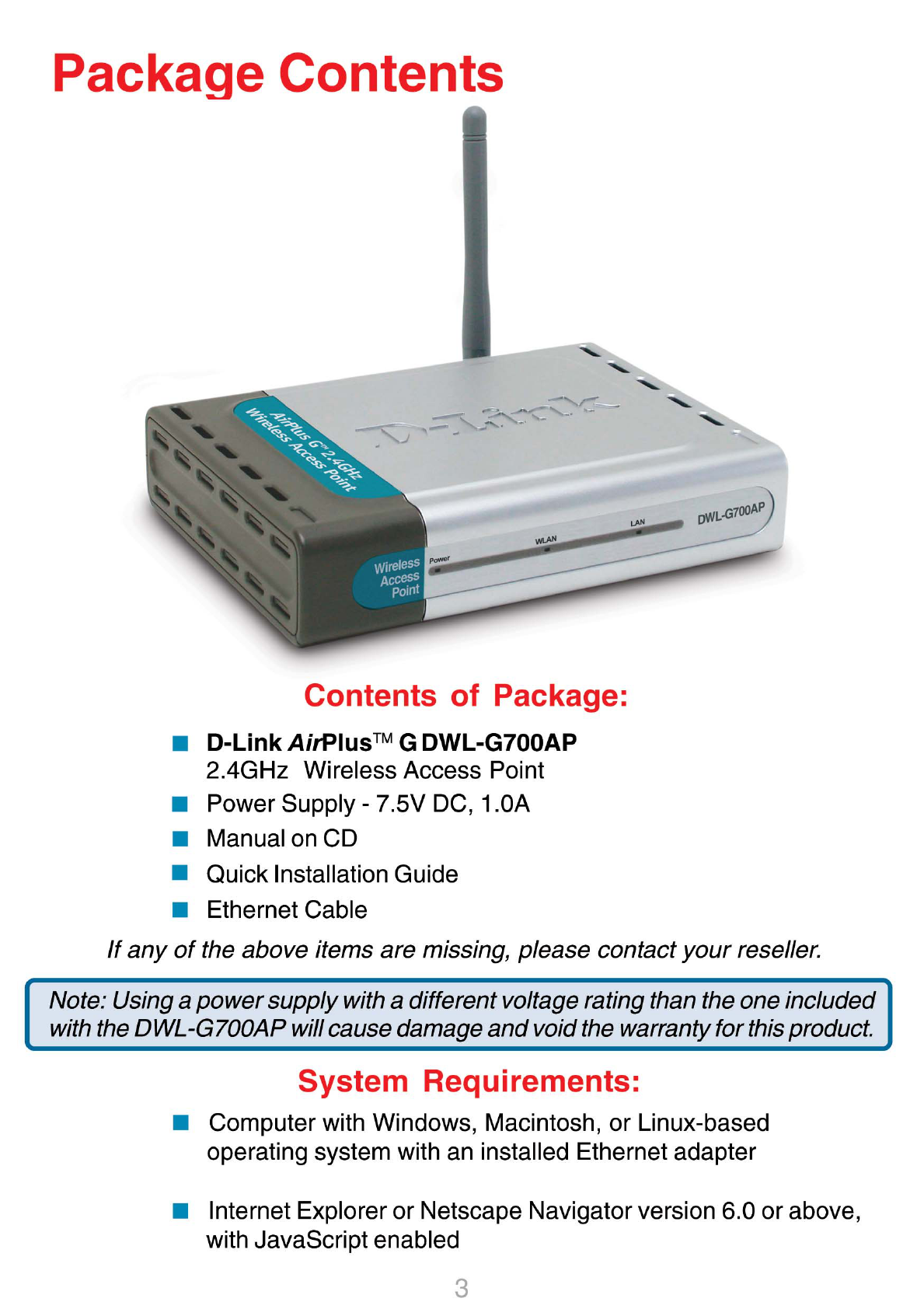
4
Introduction
At up to five times the speed of previous wireless devices (up to 54Mbps), you can work
faster and more efficiently, increasing productivity. With the DWL-G700AP, bandwidth-
intensive applications like graphics or multimedia will benefit significantly because large
files are able to move across the network quickly.
The D-Link AirPlusTM G DWL-G700AP Wireless Access Point is an 802.11g high-
performance, wireless device that is also compatible with 802.11b devices. It is an ideal
way to extend the reach and number of computers connected to your wireless network.
Capable of data transfer rates up to 54Mbps, when used with other D-Link AirPlus G
products, the DWL-G700AP is compatible with most popular operating systems, including
Macintosh, Linux and Windows, and can be integrated into a large network.
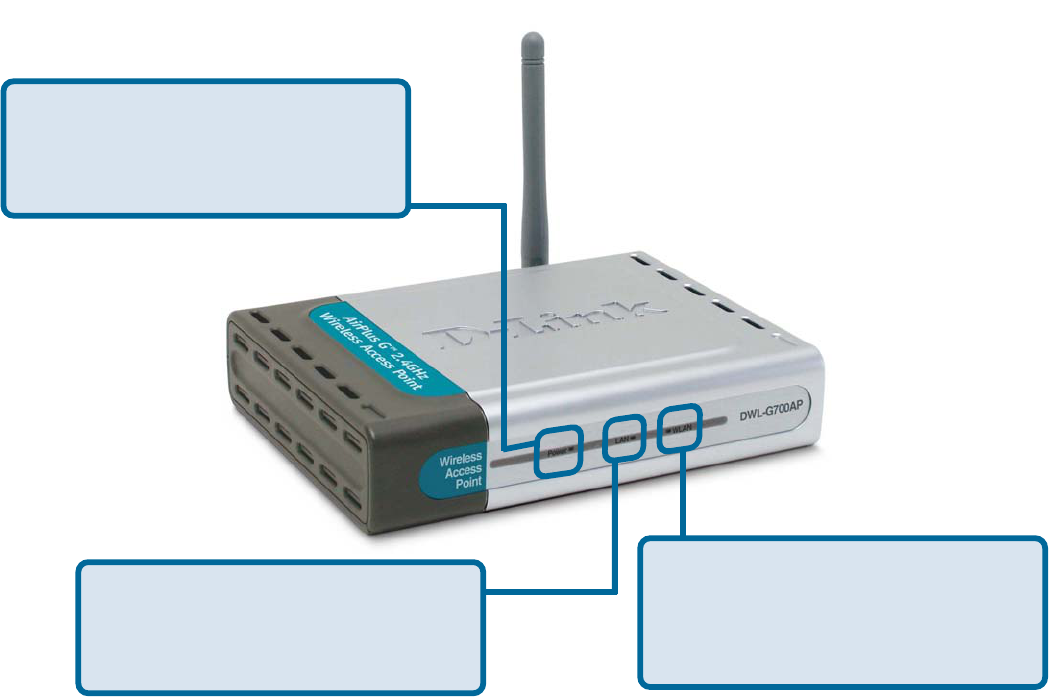
5
Up to 5X Faster with AirPlus G Products - high-speed wireless data transfer
rates up to 54Mbps. With increased data rate and capacity, the DWL-G700AP
delivers media rich content such as digital images, videos, and MP3 files much
faster than standard 802.11b networks.
Fully 802.11b Compatible – Fully compatible with the IEEE 802.11b
standard and interoperable with all existing 802.11b compliant devices.
Network Security with up to 128-bit WEP Encryption – Supports 64/128-
bit WEP encryption for a level of security for your data and wireless
communication.
Built-in DHCP Server – If enabled, it will automatically assign IP addresses
to wireless clients on the local network.
Web-based interface for Managing and Configuring – Easy-to-use
interface independent of the operating system.
Features and Benefits
LEDS
LED stands for Light-Emitting Diode. The DWL-G700AP Wireless Access Point has
3 LEDs as shown below:
LAN: blinking green light
indicates wireless activity;
solid green light indicates
connection
WLAN: blinking green light
indicates activity; solid green
light indicates connection
Power: solid green light
indicates connection to a
power source
6
Wireless Basics
D-Link wireless products are based on industry standards to provide easy-to-use and
compatible high-speed wireless connectivity within your home, business or public access
wireless networks. D-Link wireless products will allow you access to the data you want,
when and where you want it. You will be able to enjoy the freedom that wireless networking
brings.
A Wireless Local Area Network (WLAN) is a computer network that transmits and receives
data with radio signals instead of wires. WLANs are used increasingly in both home and
office environments, and public areas such as airports, coffee shops and universities.
Innovative ways to utilize WLAN technology are helping people to work and communicate
more efficiently. Increased mobility and the absence of cabling and other fixed
infrastructure have proven to be beneficial for many users.
Wireless users can use the same applications they use on a wired network. Wireless
adapter cards used on laptop and desktop systems support the same protocols as
Ethernet adapter cards.
People use WLAN technology for many different purposes:
Mobility - Productivity increases when people have access to data in any location
within the operating range of the WLAN. Management decisions based on real-time
information can significantly improve worker efficiency.
Low Implementation Costs –WLANs are easy to set up, manage, change and
relocate. Networks that frequently change can benefit from WLANs ease of
implementation. WLANs can operate in locations where installation of wiring may be
impractical.
Installation and Network Expansion -Installing a WLAN system can be fast
and easy and can eliminate the need to pull cable through walls and ceilings. Wireless
technology allows the network to go where wires cannot go - even outside the home or
office.
Scalability –WLANs can be configured in a variety of ways to meet the needs of
specific applications and installations. Configurations are easily changed and range
from peer-to-peer networks suitable for a small number of users to larger infrastructure
networks to accommodate hundreds or thousands of users, depending on the number
of wireless devices deployed.
Inexpensive Solution - Wireless network devices are as competitively priced as
conventional Ethernet network devices.
7
Installation Considerations
Keep in mind, that the number, thickness and location of walls, ceilings, or other objects
that the wireless signals must pass through, may limit the range. Typical ranges vary
depending on the types of materials and background RF (radio frequency) noise in your
home or business. The key to maximizing wireless range is to follow these basic
guidelines:
Wireless Basics (continued)
Keep the number of walls and ceilings between the DWL-G700AP and other
network devices to a minimum - each wall or ceiling can reduce your DWL-G700AP’s
range from 3-90 feet (1-30 meters.) Position your devices so that the number of
walls or ceilings is minimized.
Be aware of the direct line between network devices. A wall that is 1.5 feet thick
(.5 meters), at a 45-degree angle appears to be almost 3 feet (1 meter) thick. At
a 2-degree angle it looks over 42 feet (14 meters) thick! Position devices so
that the signal will travel straight through a wall or ceiling (instead of at an angle)
for better reception.
2
Building materials can impede the wireless signal - a solid metal door or aluminum
studs may have a negative effect on range. Try to position wireless devices and
computers with wireless adapters so that the signal passes through drywall or
open doorways and not other materials.
3
Keep your product away (at least 3-6 feet or 1-2 meters) from electrical devices
or appliances that generate RF noise.
4
1
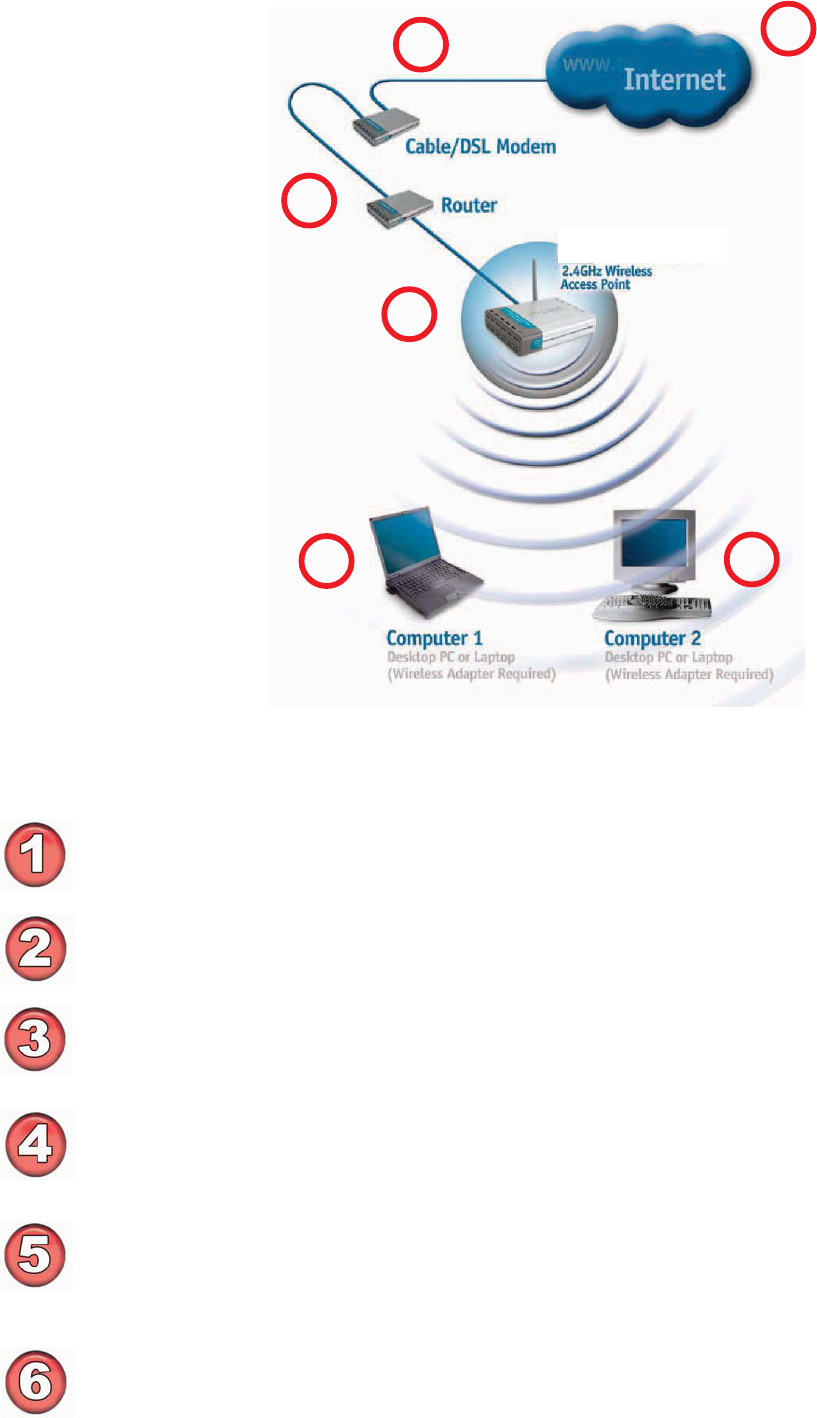
8
Please remember that D-Link AirPlus G wireless devices are pre-configured to
connect together, right out of the box, with their default settings.
You will need broadband Internet access (a Cable or DSL-subscriber line into
your home or office)
Consult with your Cable or DSL provider for proper installation of the modem
Connect the Cable or DSL modem to your broadband router (see the Quick
Installation Guide included with your router.)
If you are connecting a desktop computer in your network, you can install the
D-Link AirPlus G DWL-G510 wireless PCI adapter into an available PCI slot on
your desktop computer.
(See the Quick Installation Guide included with the DWL-G510.)
Install the drivers for the wireless Cardbus adapter into a laptop computer.
(e.g, the DWL-G630; See the Quick Installation Guide included with the
DWL-G630.)
Setting up a Wireless
Infrastructure Network
66
66
6
22
22
211
11
1
33
33
3
44
44
4
Getting Started
Connect the router to the D-Link AirPlus G DWL-G700AP.
(See the Quick Installation Guide included with the DWL-G700AP.)
For a typical wireless setup at home (as shown above), please do the following:
55
55
5
DWL-G700AP
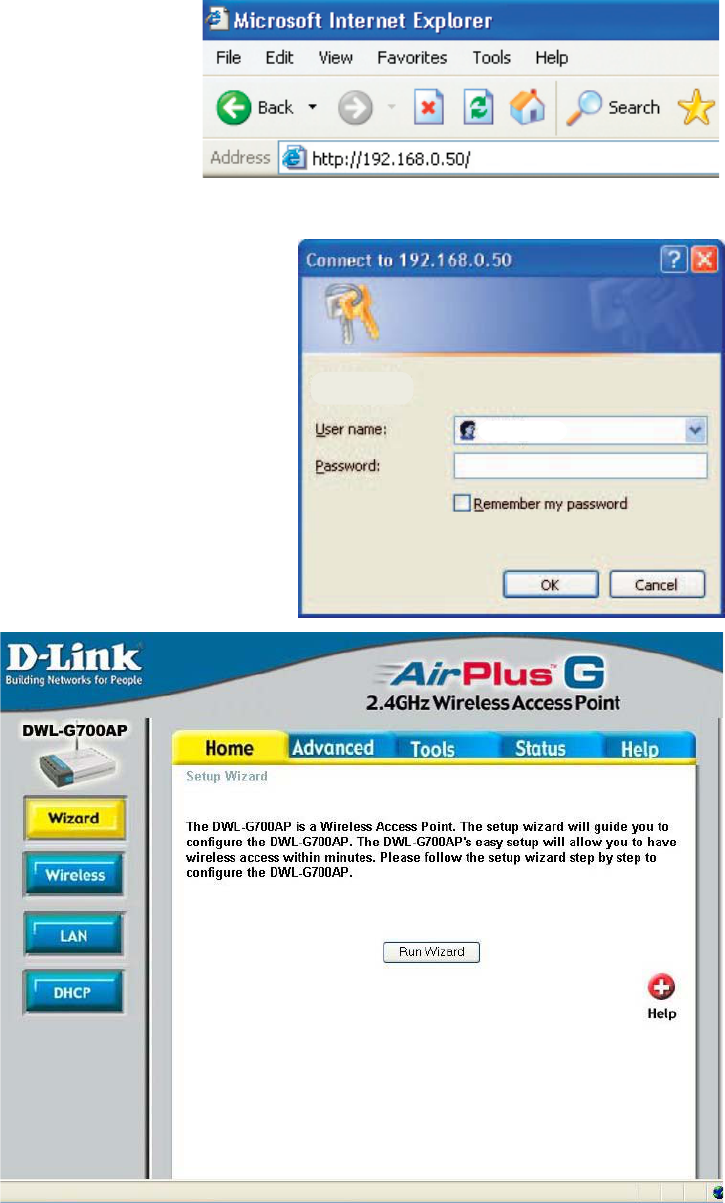
9
After you have completed the initial installation and the Setup Wizard (as illustrated in
the Quick Installation Guide that is included with the DWL-G700AP), you can access
the configuration menu, at any time, by opening the web-browser and typing in the IP
address of the DWL-G700AP. The DWL-G700AP’s default IP address is shown below:
Open the web browser
Type in the IP address of the
DWL-G700AP. (192.168.0.50).
Type admin in the
User Name field
Leave the Password
blank
Click OK
admin
Using the Configuration Utility
If you wish to change the default settings or optimize the performance of the
DWL-G700AP, D-Link has included a configuration utility for this purpose.
Note: If you have changed the default IP address assigned to the DWL-G700AP, make
sure to enter the correct IP address.
The Home>Wizard screen
will appear. Please refer to
the Quick Installation Guide
for more information
regarding the Setup Wizard.
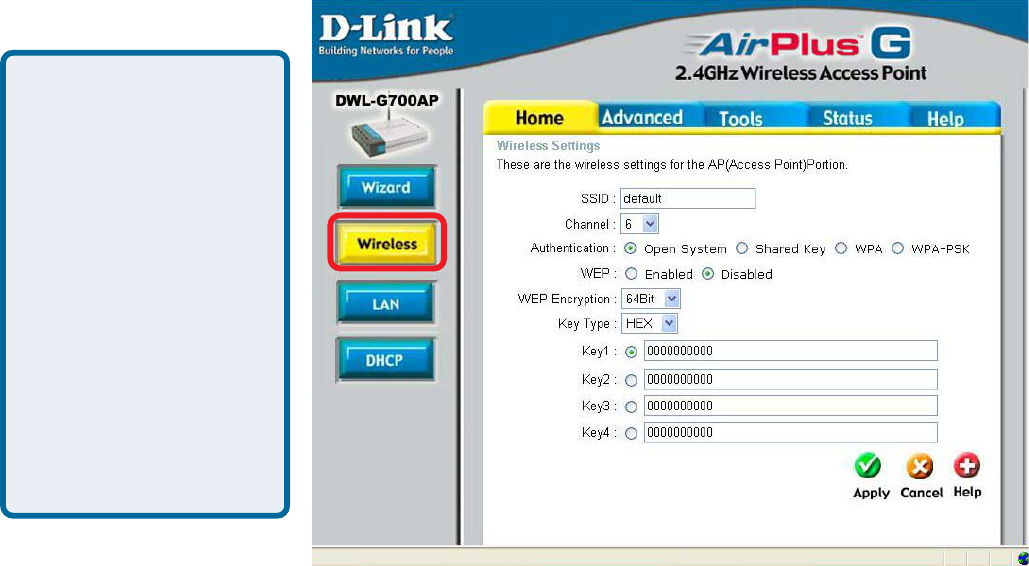
10
Using the Configuration Utility (continued)
Home > Wireless
ASCII (American
Standard Code for
Information
Interchange) is a
code for
representing
English letters as
numbers from 0-
127
Hexadecimal
digits consist of
the numbers 0-9
and the letters A-F
SSID: (Service Set Identifier) Default is the default setting. The SSID is a unique
name that identifies a network. All devices on a network must share the same SSID
name in order to communicate on the network. If you choose to change the SSID from
the default setting, input your new SSID name in this field.
Channel: Channel 6is the default channel. Input a new number if you want to change
the default setting. All devices on the network must be set to the same channel to
communicate on the network.
Authentication:
WEP: Select Enabled or Disabled.
WEP Encryption: Select 64-bit or 128-bit WEP encryption.
Key Type: Select Hexadecimal or ASCII key type
Keys 1-4: Input up to four encryption keys. You will select one of these to be the active key.
Apply: Click Apply to apply the changes.
Select Open System to communicate the key across the network.
Select Shared Key to limit communication only to those devices
that share the same WEP settings.
Select WPA to select Wi-Fi Protected Access in conjunction with a
RADIUS server in your network
Select WPA-PSK to select Wi-Fi Protected Access without a
RADIUS server.
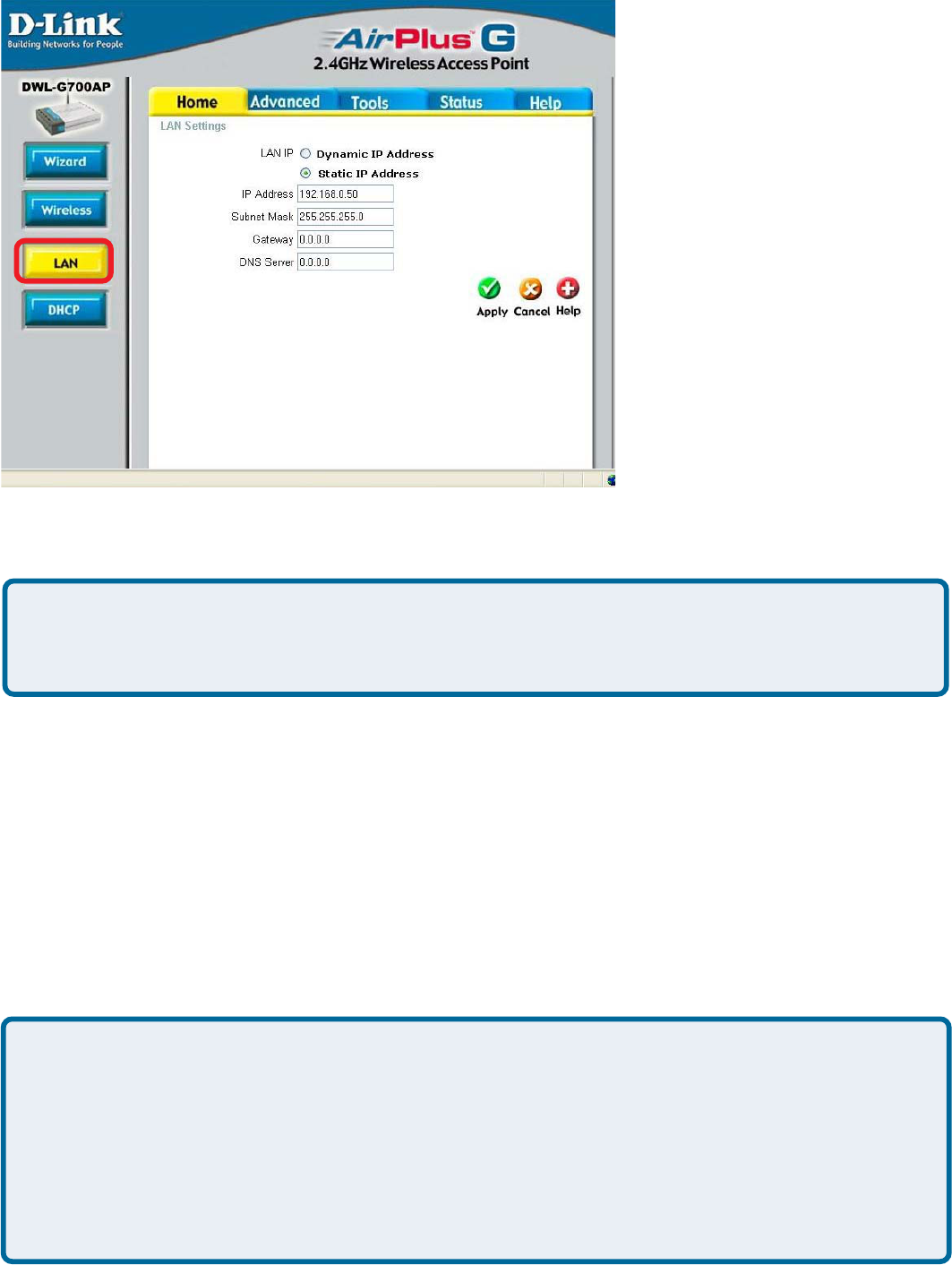
11
Using the Configuration Utility (continued)
Dynamic IP Address: Select this option if you would like to have an IP Address
automatically assigned to the DWL-G700AP by a DHCP server in your network.
DHCP stands for Dynamic Host Configuration Protocol. It is a protocol for assigning
dynamic IP addresses “automatically.” With a DHCP Server there is no need to
manually assign an IP Address.
Static IP Address: Select this option if you are manually assigning an IP Address.
IP Address: 192.168.0.50 is the default IP Address of the Access Point.
Subnet Mask: 255.255.255.0 is the default Subnet Mask. All devices on the
network must have the same subnet mask to communicate on the network.
Gateway: Enter the IP Address of the router in your network
DNS Server:
Home > LAN
IP Address
If you need to assign static IP addresses to the devices in your network, please
remember that the IP address for each computer or device must be in the same IP
address range as all the devices in the network. Each device must also have the same
subnet mask. For example: Assign the first computer an IP address of 192.168.0.2
and a subnet mask of 255.255.255.0, the second device an IP address of 192.168.0.3
and a subnet mask of 255.255.255.0, and so on. Note: Devices that are assigned
the same IP address may not be visible on the network.
Enter the IP address of the DNS server. The DNS server translates
domain names such as www.dlink.com into IP addresses.
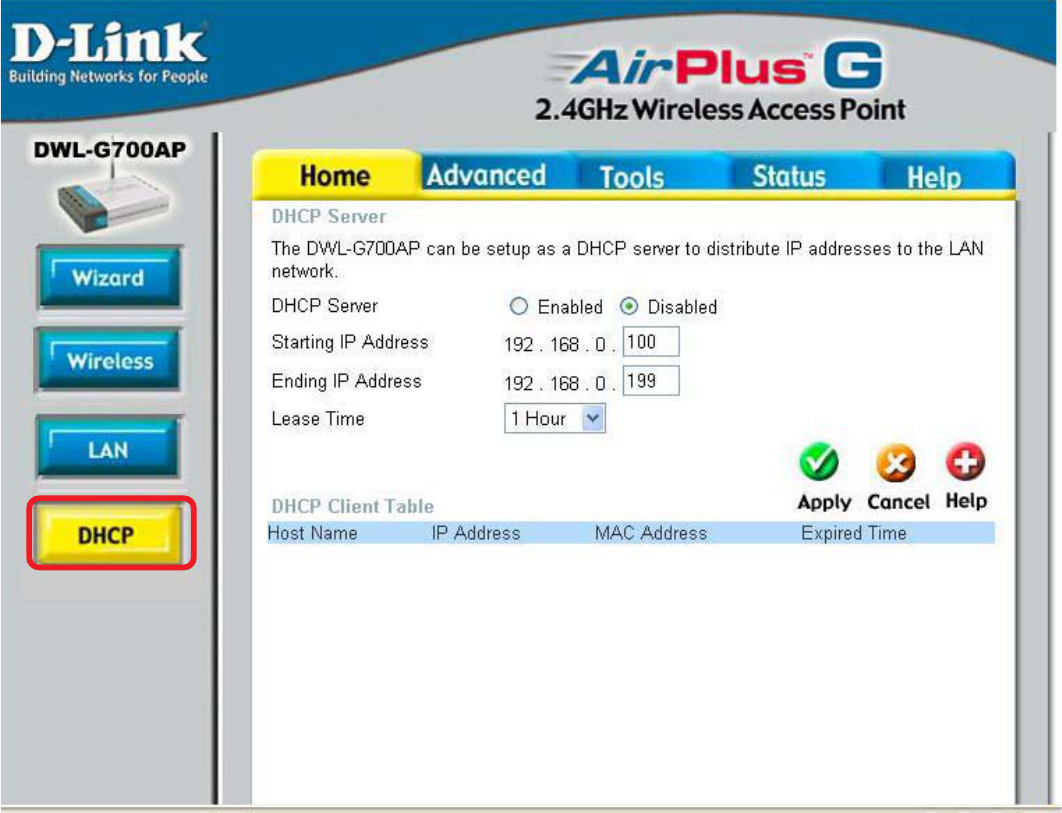
12
Using the Configuration Utility (continued)
Home > DHCP
DHCP Server: Select Enabled or Disabled. Disabled is the default setting.
If you want to use the DWL-G700AP as a DHCP server, to automatically assign
dynamic IP addresses on the network, you will select Enabled.
Starting IP Address: If you have enabled the DHCP server function, enter the
starting point of the IP address range for your network.
Ending IP Address: Enter the ending IP address of your IP address range, if you
have enabled the DHCP function of the DWL-G700AP.
Lease Time: Choose the length of time during which the DHCP function of the
DWL-G700AP automatically regenerates the IP addresses to the devices in your network.
DHCP Client Table: Lists the devices on your network that are receiving dynamic
IP addresses from the DWL-G700AP.
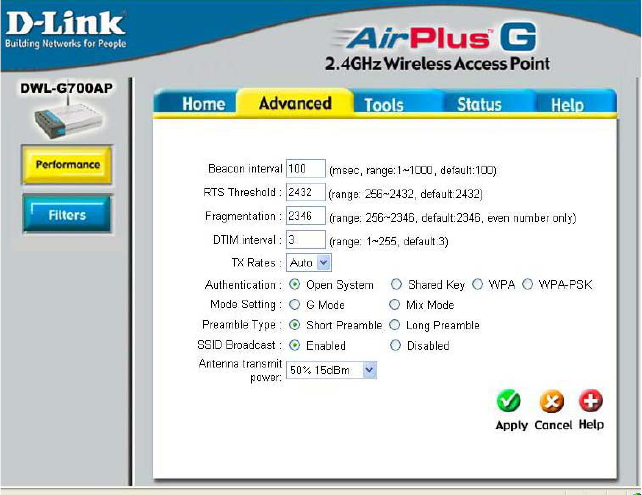
13
Using the Configuration Utility (continued)
Advanced > Performance
Beacon Interval: Beacons are
packets sent by an access point
to synchronize a wireless network.
Specify a beacon interval value.
Default (100) is recommended.
RTS Threshold: This value
should remain at its default
setting of 2,432. If you encounter
inconsistent data flow, only minor
modifications to the value range
between 256 and 2,432 are
recommended.
Fragmentation: This value
should remain at its default setting
of 2,346. If you experience a high packet error rate, you may slightly increase your
fragmentation threshold within the value range of 256 to 2,346. Setting the fragmentation
threshold too low may result in poor performance.
DTIM Interval (Beacon Rate):(Delivery Traffic Indication Message) Enter a value
between 1 and 255 (default is 3) for the Delivery Traffic Indication Message (DTIM.) A
DTIM is a countdown informing clients of the next window for listening to broadcast and
multicast messages.
TX Rates: Select the transmission rate for the network.
Authentication:
Open System - Communicates the key across the network.
Shared Key - Devices must have identical WEP settings to communicate.
WPA - WPA authentication in conjunction with a RADIUS server.
WPA-PSK - WPA authentication without a RADIUS server in the network.
Mode Setting: For utmost speed, select G Mode to include only 802.11g devices in
your network. Select Mix Mode to include 802.11g and 802.11b devices in your network.
Preamble: Long Preamble is the default setting. (High traffic networks should use the
shorter preamble type.) The preamble defines the length of the CRC block (Cyclic
Redundancy Check is a common technique for detecting data transmission errors) used
in communication between the access point and the wireless network adapters.
SSID Broadcast: (Service Set Identifier) Enable or Disable (default) the broadcast of
the SSID name across the network. SSID is a name that identifies a wireless network.
All devices on a network must use the same SSID to establish communication.
Antenna Transmit Power: Select the transmission power of the antenna. Limiting
antenna power can be useful for security purposes.
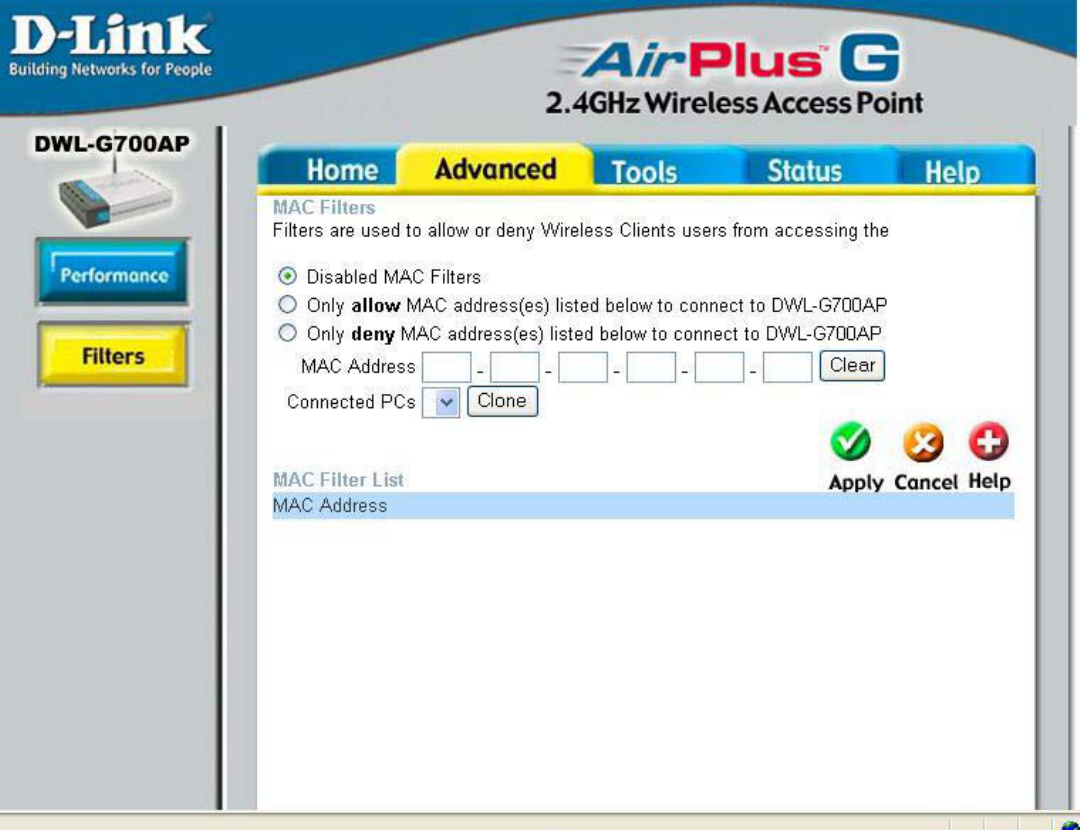
14
Using the Configuration Utility (continued)
Advanced > Filters
Use MAC Filters to allow or deny wireless clients, by their MAC addresses, from
accessing the DWL-G700AP. You can manually add a MAC address or select the MAC
address from the list of clients that are currently connected to the router (Connected
PCs). The default setting is Disabled MAC Filters.
MAC Filter List: This list will display the MAC addresses that are in the selected filter.
DWL-G700AP
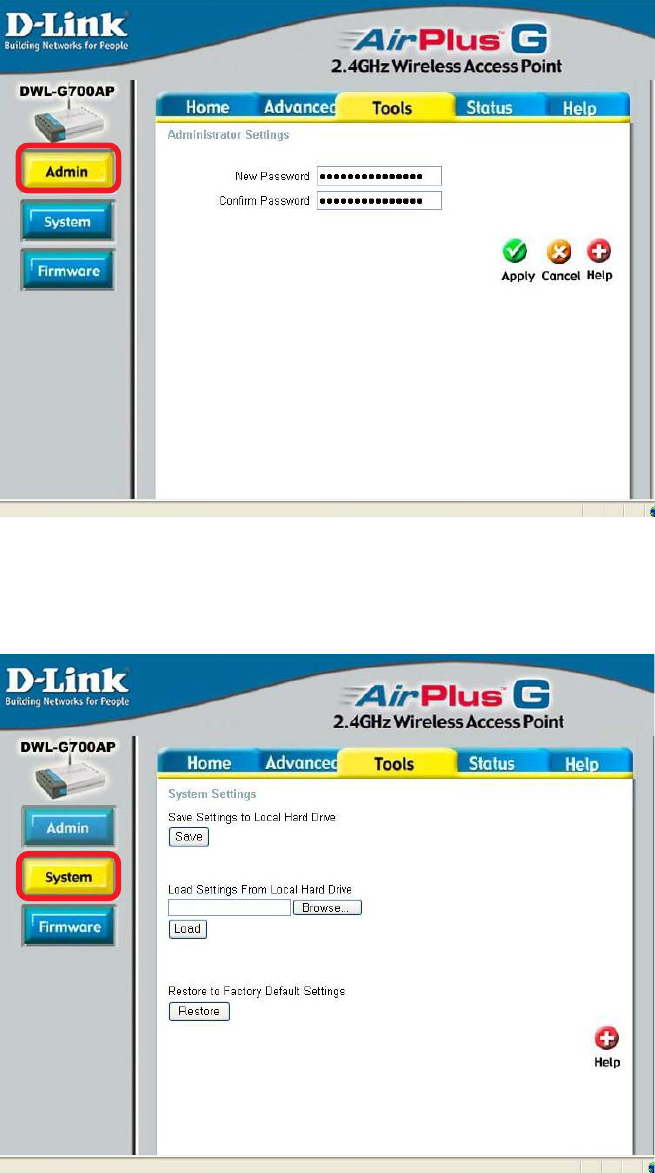
15
Using the Configuration Utility (continued)
Tools > Admin
New Password: Enter the
new password.
Confirm Password:
Re-enter the password to
confirm it.
Tools > System
Save Settings: The current
system settings can be saved
as a file onto the local hard
drive.
Load Settings: The saved file
or any other saved setting file
can be loaded back on the access
point. To reload a system settings
file, click on Browse to browse
the local hard drive and locate
the system file to be used. Click
Load when you have selected
the file to be loaded back onto
the access point.
Restore: You may also reset
the DWL-G700AP back to factory settings by clicking on Restore. Make sure to save
the unit’s settings before clicking on Restore. You will lose your current settings when
you click Restore.
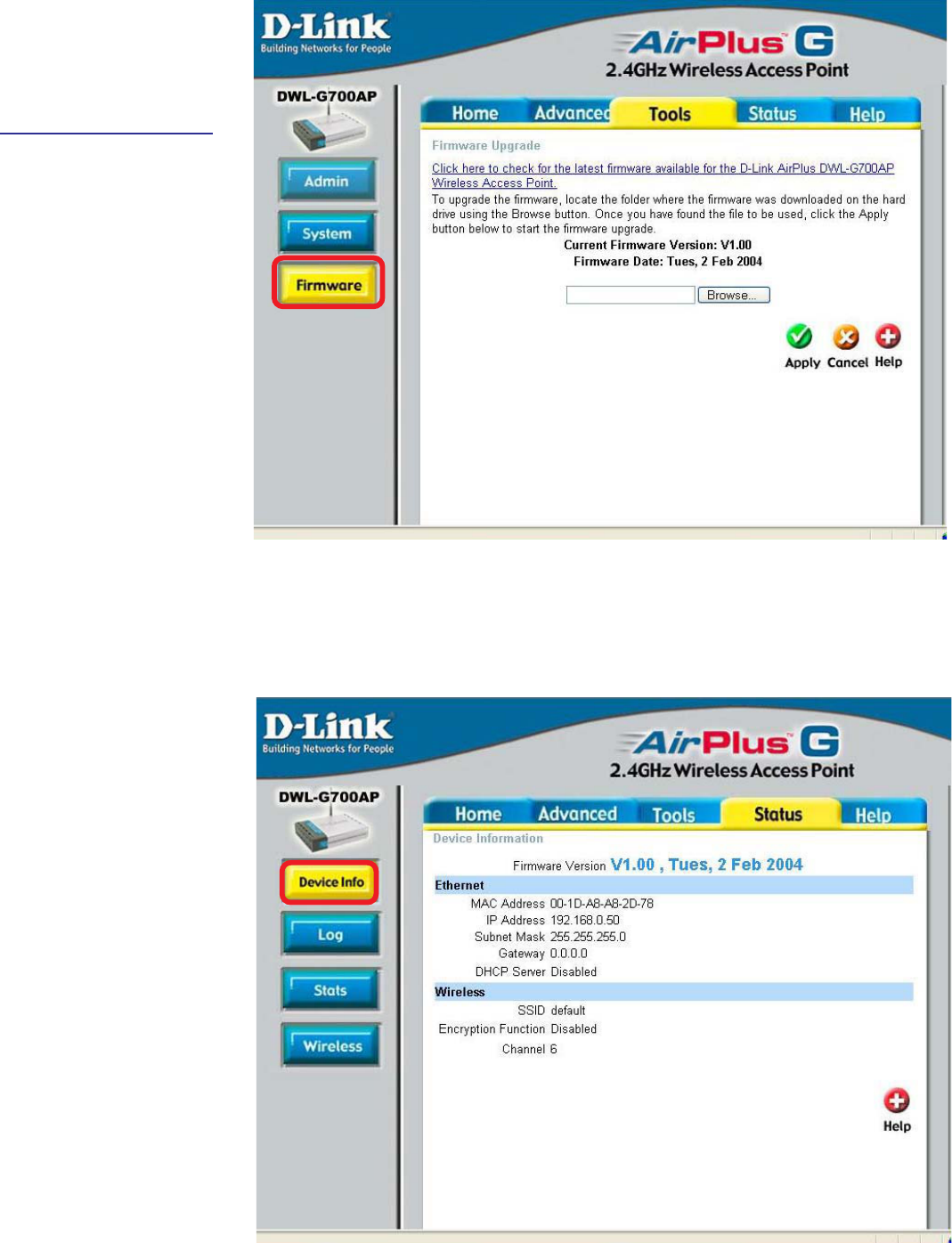
16
Using the Configuration Utility (continued)
Tools > Firmware
You can upgrade the
firmware of the
DWL-G700AP at this
page. When you click
Click here to check... in
this window you will be
connnected to D-Link’s
website, where you can
download the latest
firmware update. After
you have completed the
firmware download to
your hard drive, click
Browse to browse your
local hard drive and
locate the firmware to be
used for the update.
Click Apply.
Status > Device Info
This screen displays
the current firmware
version, and the
current wireless and
Ethernet settings of
the DWL-G700AP.
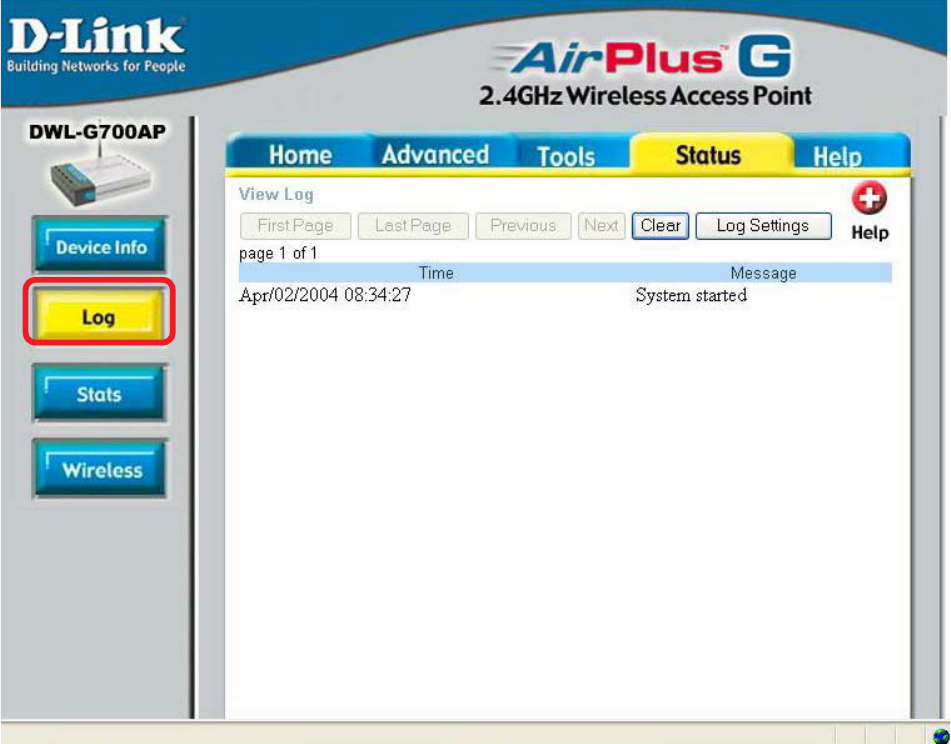
17
Using the Configuration Utility (continued)
Status > Log
View Log
The DWL-G700AP keeps a running log of events and activities occurring on the AP. If the
device is rebooted, the logs are automatically cleared. You may save the log files under
Log Setting.
First Page - The first page of the log.
Last Page - The last page of the log.
Previous - Moves back one log page.
Next - Moves forward one log page.
Clear - Clears the logs completely.
Log Settings - Brings up the page to configure the logs.
Log Settings
Not only does the DWL-G700AP display the logs of activities and events, it can be
setup to send these logs to another location. The logs can be sent via email to an email
account.
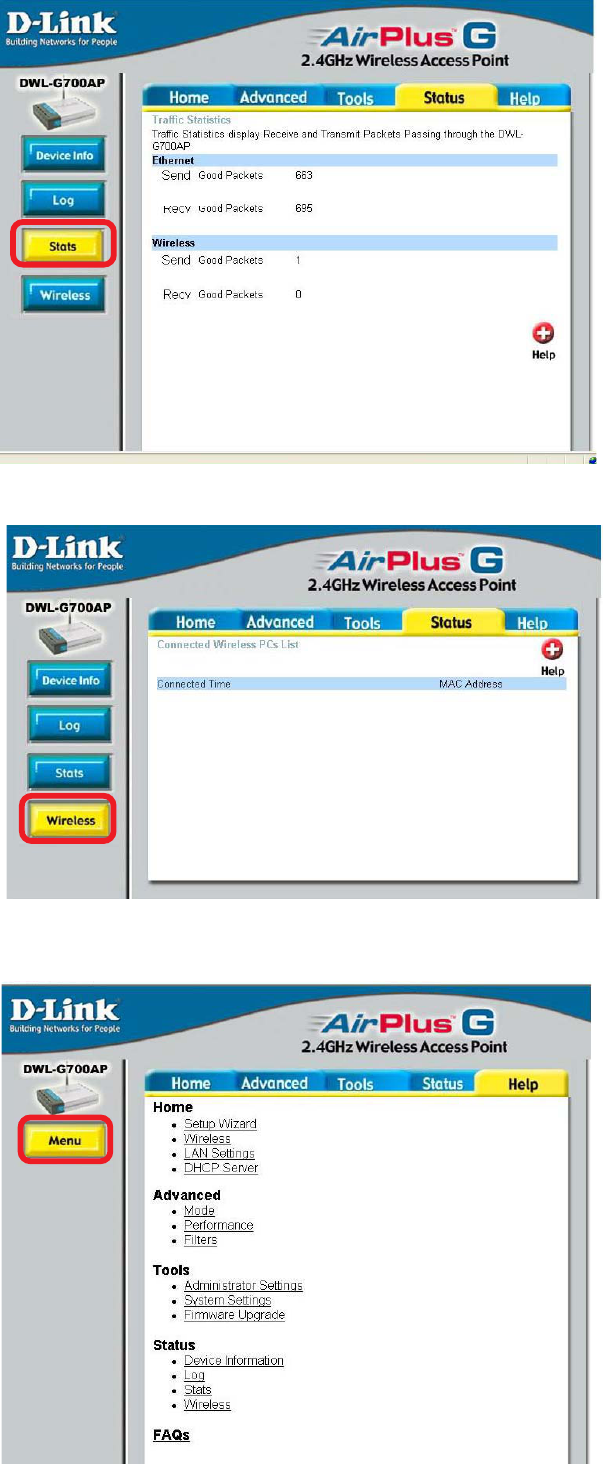
18
Using the Configuration Utility (continued)
Status> Stats
Traffic Statistics
The DWL-G700AP keeps statistics
of traffic that passes through it. You
are able to view the amount of
packets that pass through the
Ethernet and wireless portions of
the network. The traffic counter will
reset if the device is rebooted.
Status > Wireless
Connected
Wireless PCs List
This list displays the MAC
Addresses of connected PCs and
the length of time that they have
been connected.
Help
Select from this menu for extra
help.
Menu
DWL-700AP
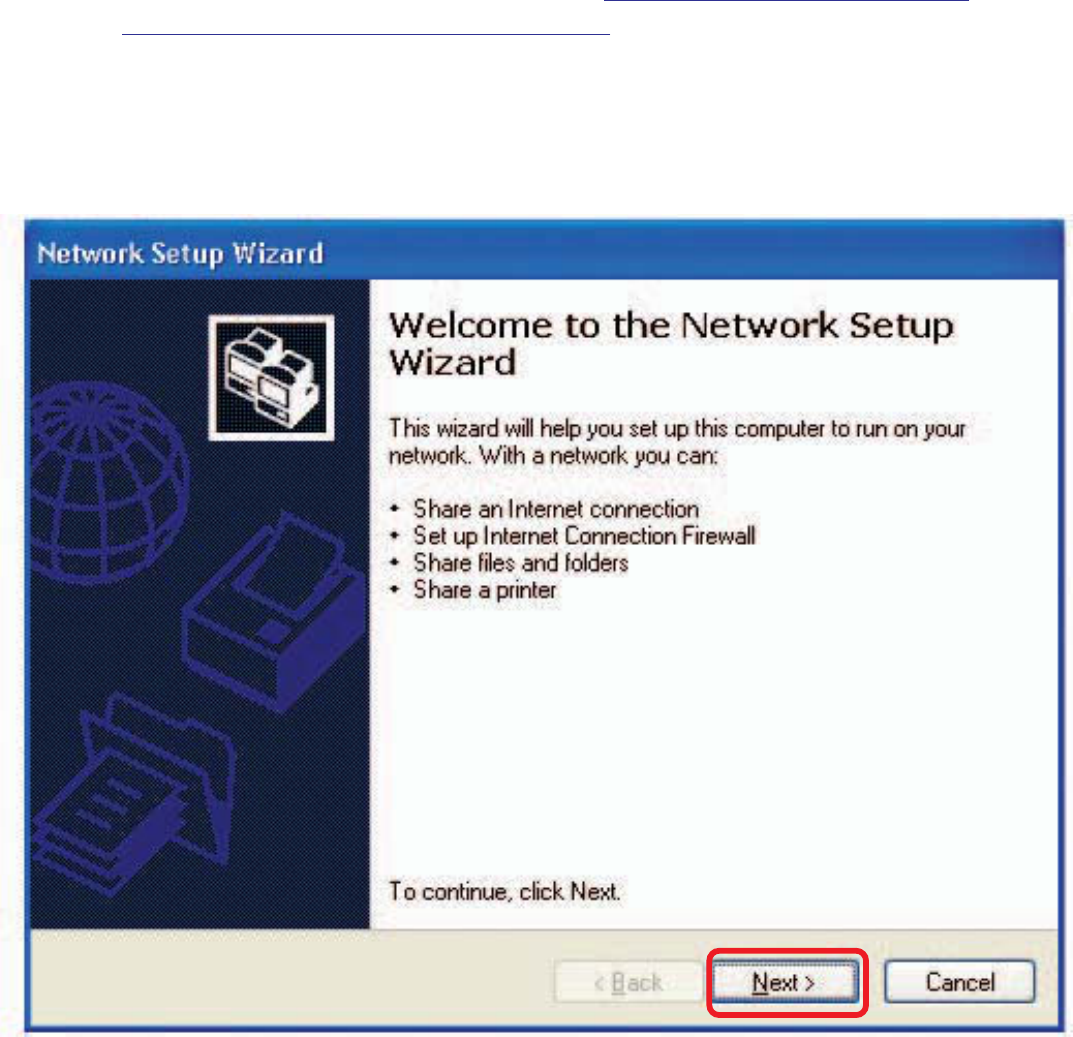
19
Using the Network Setup Wizard in Windows XP
In this section you will learn how to establish a network at home or work, using
Microsoft Windows XP.
Note: Please refer to websites such as http://www.homenethelp.com
and http://www.microsoft.com/windows2000 for information about networking
computers using Windows 2000, Me or 98SE.
Go to Start>Control Panel>Network Connections
Select Set up a home or small office network
Networking Basics
When this screen appears, click Next.
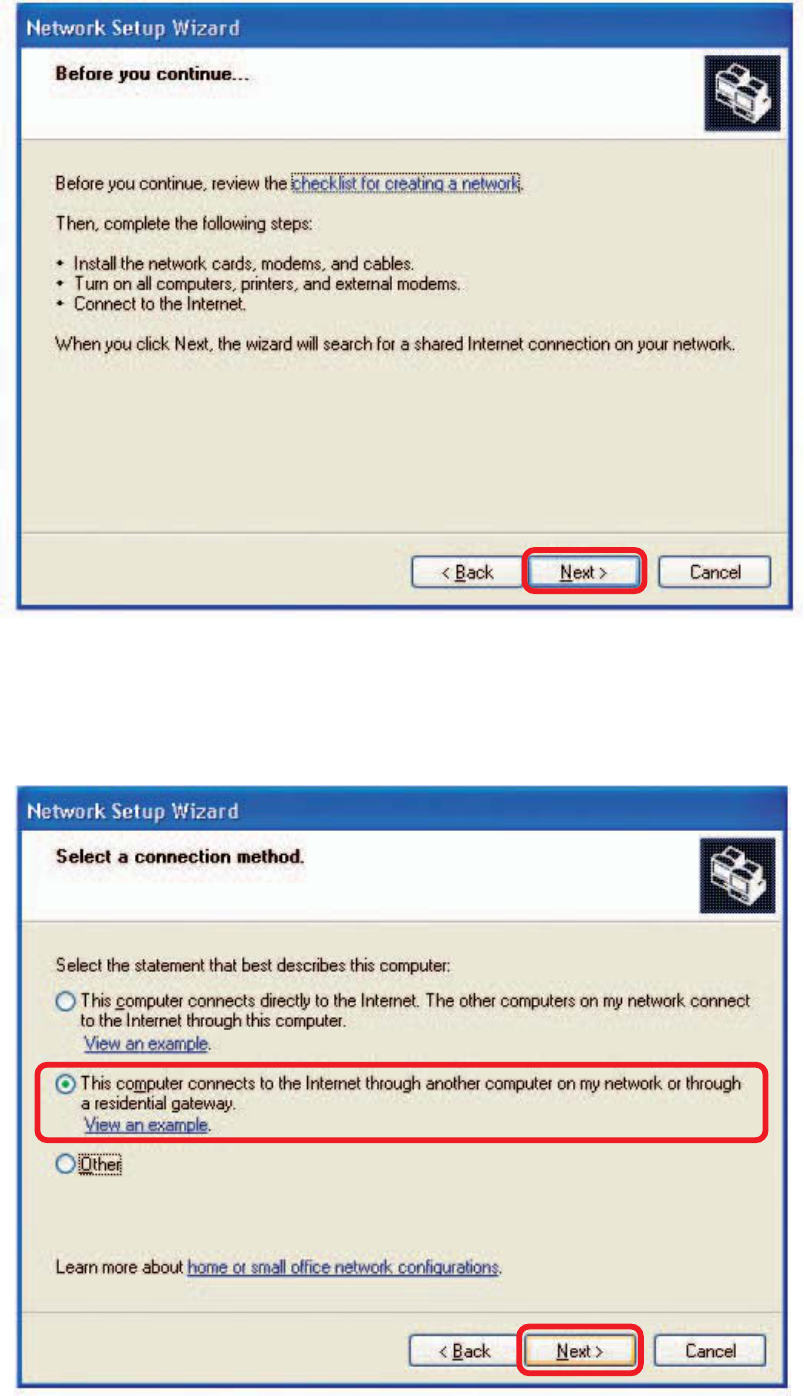
20
Please follow all the instructions in this window:
Networking Basics (continued)
Click Next.
In the following window, select the best description of your computer. If your
computer connects to the internet through a gateway/router, select the second option
as shown.
Click Next.
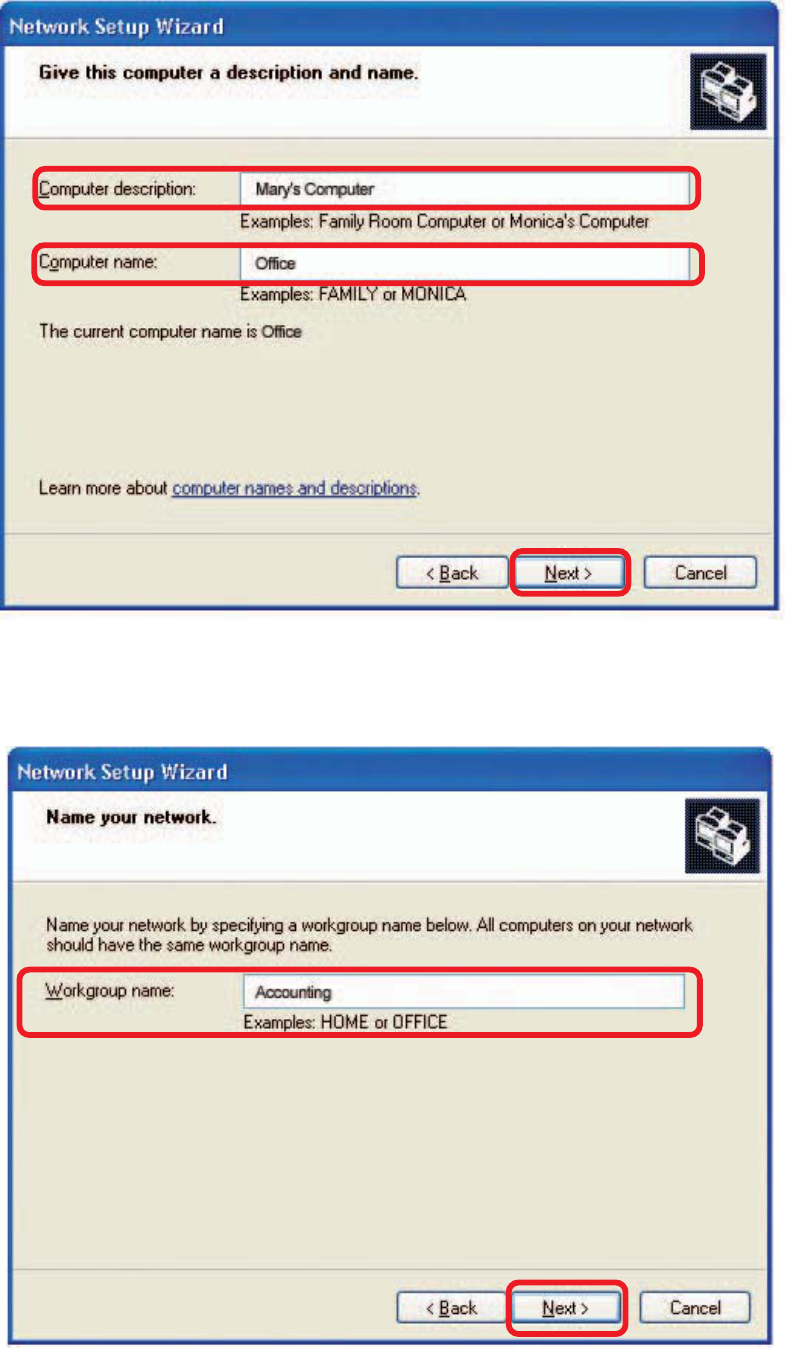
21
Enter a Computer description and a Computer name (optional.)
Networking Basics (continued)
Click Next.
Enter a Workgroup name. All computers on your network should have the same
Workgroup name.
Click Next.
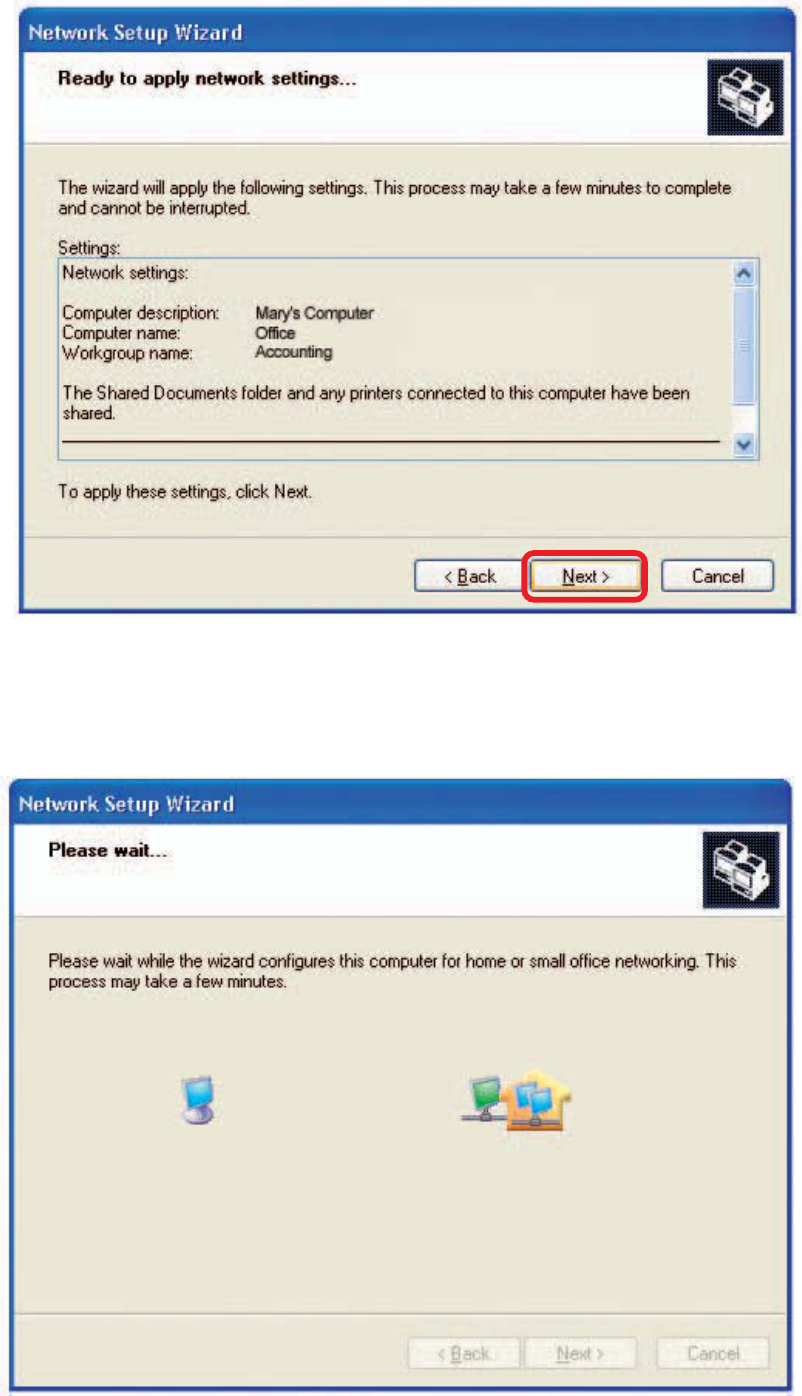
22
Please wait while the Network Setup Wizard applies the changes.
Networking Basics (continued)
When the changes are complete, click Next.
Please wait while the Network Setup Wizard configures the computer.
This may take a few minutes.
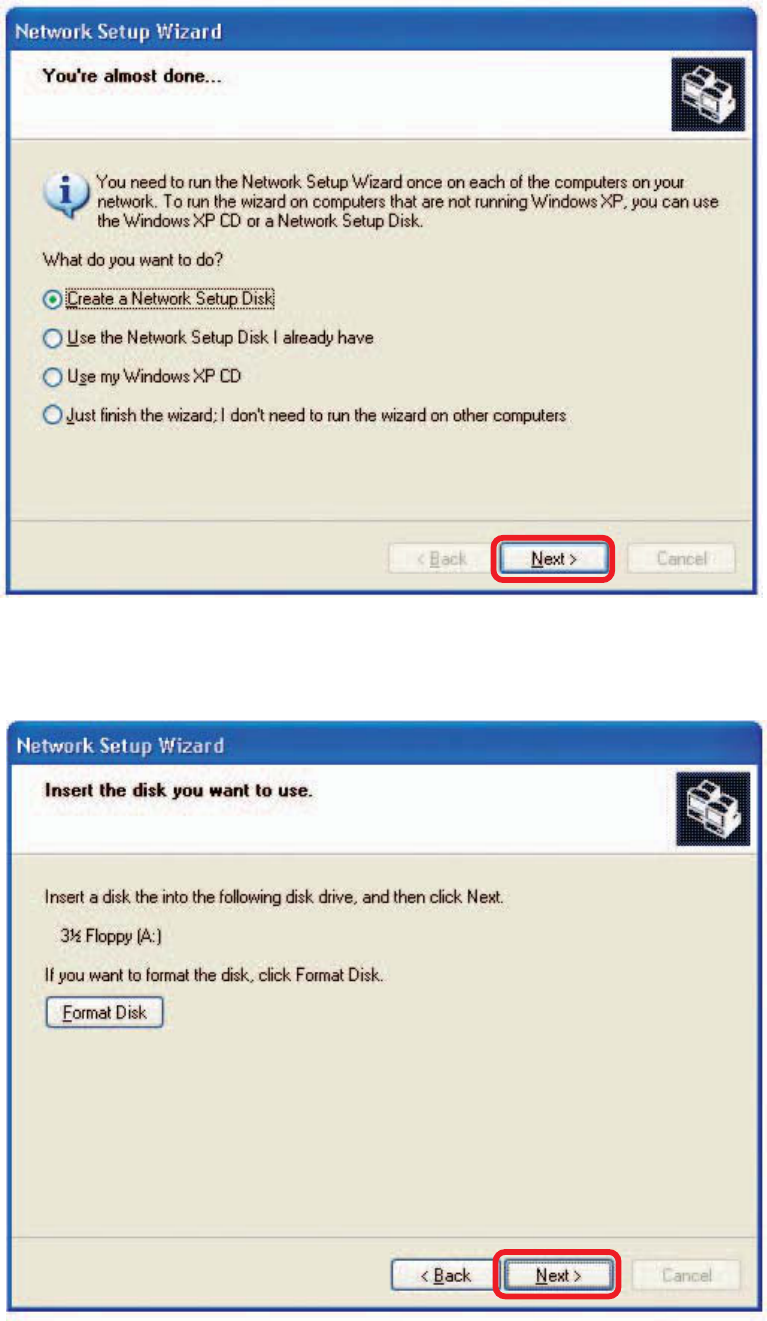
23
Networking Basics (continued)
In the window below, select the option that fits your needs. In this example, Create a
Network Setup Disk has been selected. You will run this disk on each of the
computers on your network. Click Next.
Insert a disk into the Floppy Disk Drive, in this case drive A.
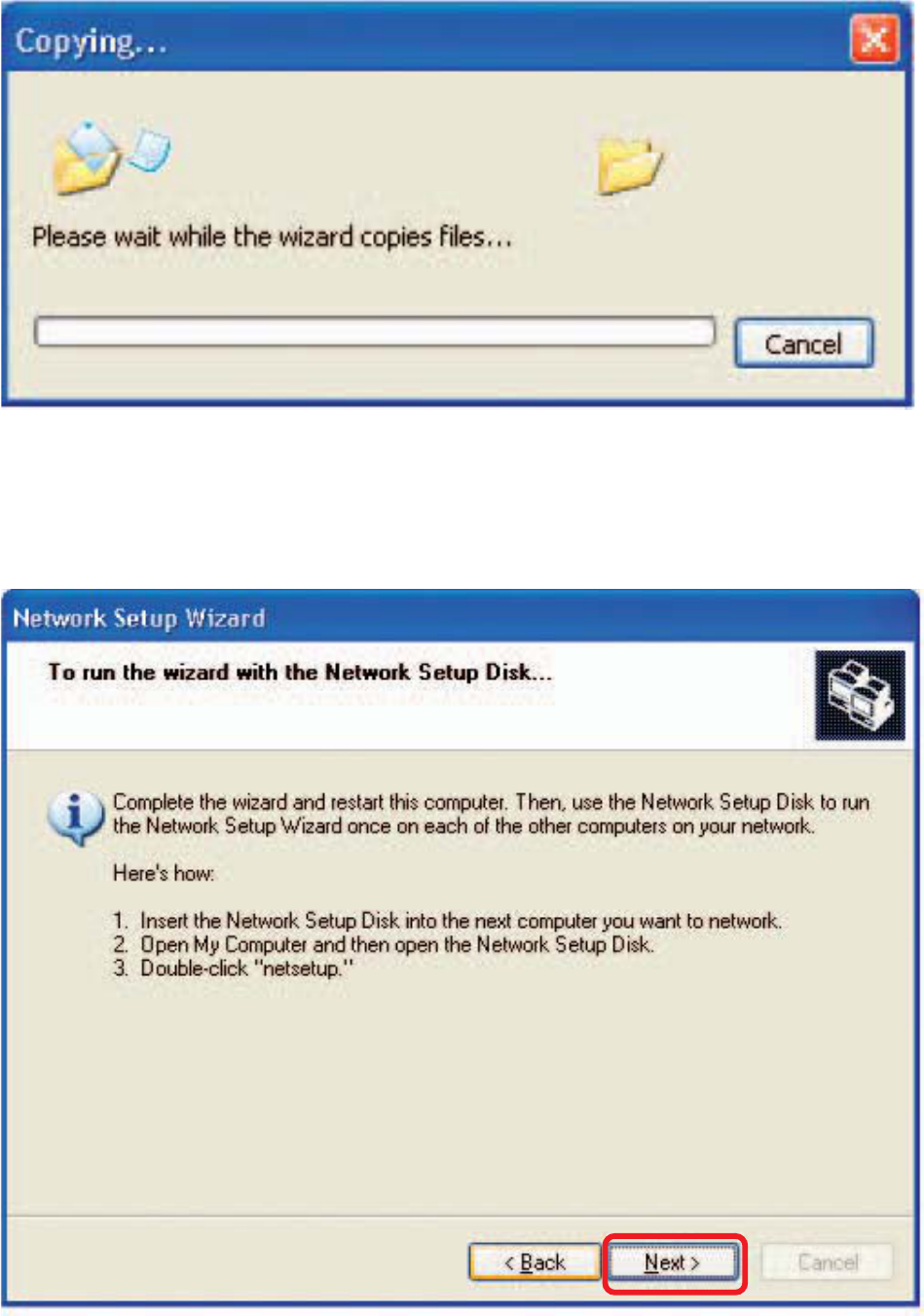
24
Networking Basics (continued)
Please read the information under Here’s how in the screen below. After you com-
plete the Network Setup Wizard you will use the Network Setup Disk to run the
Network Setup Wizard once on each of the computers on your network. To continue
click Next.
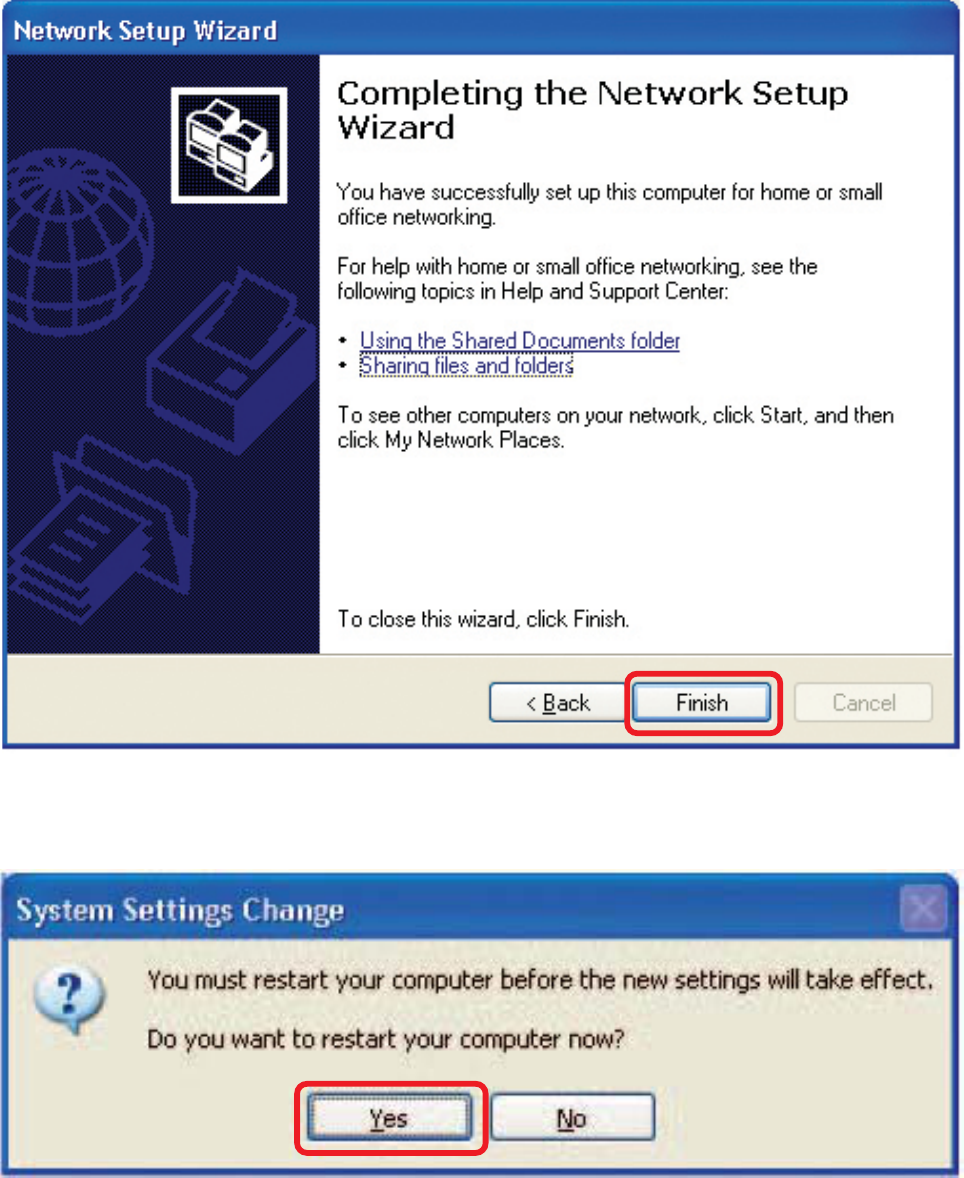
25
Networking Basics (continued)
Please read the information on this screen, then click Finish to complete the
Network Setup Wizard.
The new settings will take effect when you restart the computer. Click Yes to restart
the computer.
You have completed configuring this computer. Next, you will need to run the Network
Setup Disk on all the other computers on your network. After running the Network
Setup Disk on all your computers, your new wireless network will be ready to use.